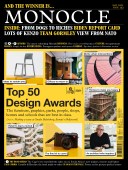
Issue 143
Monocle’s springy May issue includes the launch of our first ever Design Awards. Expect 50 movers and shakers, from architects rethinking the built environment to fresh branding, smart ateliers and products to prize. Elsewhere in the issue we pass our verdict on president Biden’s first 100 days in office, sit down with the Nato secretary-general to discuss the merits of fighting your corner and profile the soaring fortunes of the pet industry. As always, you’ll also discover stylish finds for your wardrobe alongside a world of recipes, recommendations and ideas to spark your imagination: from weekend plans to starting a new venture. Plus: making a scene in Studio Babelsberg, Germany’s answer to Hollywood.
In This Issue
Oops! No content was found.
Looks like we no longer have content for the page you're on. Perhaps try a search?
Return Home

